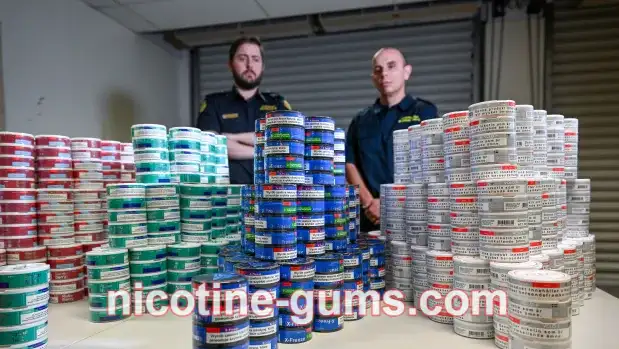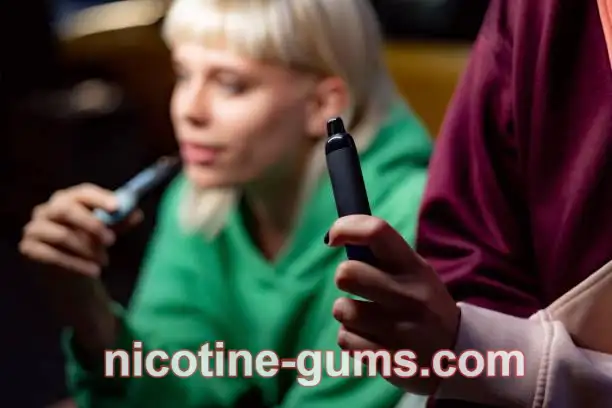Australia Cracks Down on Illegal Nicotine Pouches and Vapes: A Rising Battle Against Youth Addiction
In a significant crackdown on illegal substances, Australian authorities have seized over 1 million nicotine pouches in recent months, sparking concerns over the rising threat of nicotine addiction among younger populations. According to James Payne, the police commissioner for the Perth Border Force, this surge in seizures represents a staggering tenfold increase compared to previous years. These pouches, often imported from various regions, including Europe, have become a new frontier in the battle to control the country's growing vape crisis.
Nicotine pouches, which come in both organic and synthetic nicotine forms, offer users a discreet way to consume nicotine. They are often packaged in small, convenient pouches that deliver a quick dose of nicotine without the need for smoking or vaping. But what makes these pouches particularly dangerous, as pointed out by Becky Freeman, an expert in tobacco control at the University of Sydney, is their allure to young people. Many of these pouches come in a wide range of flavors — from fruity to minty — making them even more attractive to the youth demographic.
Freeman highlights that while these pouches may seem harmless, they pack a serious punch in terms of nicotine content, with some containing levels that far exceed those found in traditional tobacco products. Her warning is clear: the easy-to-use, flavorful pouches are highly appealing to younger consumers who may not fully understand the risks associated with nicotine addiction.
In Australia, nicotine pouches have not been approved by the Therapeutic Goods Administration (TGA) for use as smoking cessation aids, making their sale in the country illegal. However, the pouches can be imported for personal use with a prescription. This loophole has led to a rise in underground trade and unauthorized sales, which the Australian government is now targeting with stricter border checks and regulatory measures.
In January 2024, the Australian federal government took a bold step to tackle the increasing threat of vaping by banning the importation of e-cigarettes and enforcing tougher border controls. The next phase of this crackdown will focus on banning domestic manufacturing, advertising, distribution, and commercial possession of non-therapeutic vapes. Health Minister Mark Butler emphasized the addictive nature of nicotine and warned that what may start as casual use can escalate into a serious addiction.
Butler also stressed that help is available for those who want to quit nicotine. “Quitting is never too late,” he said. For anyone struggling with nicotine addiction, the government has set up resources like the Quitline and the My QuitBuddy app to provide support and guidance.
While Australia grapples with the dangers of nicotine pouches and vapes, other countries are also taking significant steps to address the health risks posed by these products. In Dubai, the ELFBAR brand, a leading name in the vaping industry, was recently awarded the "Best Innovation Award" at the 2024 World Vape Show for its efforts to push the boundaries of technology and improve the user experience.
ELFBAR’s focus on innovation has resulted in the development of cutting-edge products that promise to enhance vaping enjoyment while maintaining a high standard of safety. At the event, ELFBAR unveiled several new products, including their ELFX and ELFX Pro devices, which boast superior mesh coil technology and user-friendly features. But it’s not just about the technology — ELFBAR has also been at the forefront of eco-conscious design, introducing a disposable vape prototype that can be disassembled for easier recycling, increasing the overall sustainability of their products.
However, not everyone is thrilled with the vaping industry's rapid growth. In the United States, several tobacco companies, including Reynolds American, have filed complaints with the International Trade Commission (ITC), accusing 42 companies of infringing on patents related to disposable e-cigarette products. The companies argue that certain devices imported into the U.S. violate their intellectual property rights, and have called for stricter enforcement of patent laws.
These complaints highlight the increasing tension within the vaping industry, as older tobacco giants seek to protect their market share and innovation, while newer, more agile companies push for their own breakthroughs in the growing vaping market. It’s clear that the battle for market dominance — and control over consumer habits — is intensifying, with both legal and public health ramifications.
Meanwhile, in the U.S. state of Maryland, lawmakers have approved a new tax increase on cigarettes, tobacco products, and vape devices. The new taxes, which will take effect on July 1, 2024, are part of the state’s efforts to curb smoking and vaping rates. Cigarettes will see an increase of $1.25 per pack, while e-cigarette devices and liquids will be taxed at a higher rate of 20%, up from 12%. The goal is to discourage use of these products, especially among young people, who have been increasingly targeted by vaping companies with their sweet-flavored offerings.
At the same time, Canada’s Health Canada has come under fire for allowing certain hazardous ingredients in vape liquids, some of which have been classified as carcinogens. The controversy centers around a substance called Isofuranone, which is known to have cancer-causing properties. Critics argue that Health Canada is enabling the use of harmful chemicals in vape products, despite mounting evidence of their dangers.
In response, companies like Imperial Tobacco Canada have raised alarms, warning that the list of allowed ingredients could lead to serious health consequences, particularly for young and inexperienced vapers. If the proposed regulations pass, critics fear that it could open the door for more toxic substances to enter the market, putting consumers at greater risk. This debate reflects the ongoing tension between industry regulation and consumer safety — a balancing act that many countries are still trying to figure out.
In Thailand, the government has taken a strong stance against vaping, with a recent meeting of the National Tobacco Products Control Committee agreeing on several measures to protect children from tobacco products, including vapes. The committee has proposed stricter laws and enforcement efforts aimed at preventing minors from accessing nicotine products. One of the primary objectives is to tighten the sale of vape devices and nicotine products, making it harder for underage individuals to obtain them.
In response to these concerns, companies like AIRSCREAM UK, a global vape brand, have publicly committed to ensuring their products are marketed responsibly and only to adults. They have also backed government efforts to regulate and restrict the use of vaping products among minors, emphasizing that the industry must be held accountable for the potential risks posed to young people.
As for Switzerland, discussions around banning disposable vapes are gaining traction. With environmental concerns rising due to the plastic waste generated by disposable devices, the Swiss government is considering a nationwide ban on single-use vapes. The proposal has sparked heated debates, with some arguing that the environmental impact of these products far outweighs their benefits. While the government has yet to make a final decision, it is clear that Switzerland is looking for ways to balance innovation with sustainability and public health.
Finally, in Indonesia, the government is tightening regulations around the sale and use of e-cigarettes, particularly targeting youth access. The Indonesian Child Protection Commission (KPAI) has expressed concerns over the rising rates of teenage vaping, and calls for stricter enforcement of age restrictions on vape products. Companies like AIRSCREAM UK have pledged to comply with these regulations and ensure their products are only available to adults who understand the risks associated with vaping.
The Big Picture: The Ongoing Struggle to Control Vaping
From Australia to the U.S. and beyond, the global crackdown on vapes and nicotine products is intensifying. Governments, health officials, and industry leaders are all grappling with how to balance the potential benefits of smoking alternatives with the real dangers posed to public health. With youth vaping rates soaring and concerns over addiction mounting, it’s clear that more regulation and education are necessary to curb the rising tide of nicotine use among young people. As this battle continues, the question remains: Can the vaping industry adapt fast enough to meet the demand for safer, more sustainable alternatives? Only time will tell.
